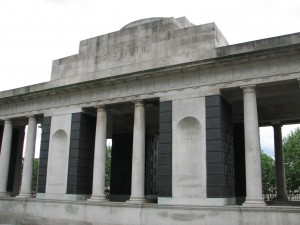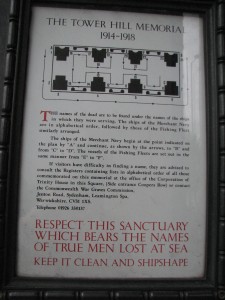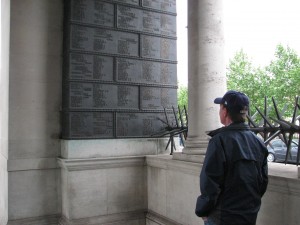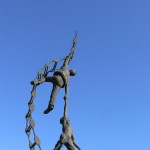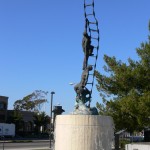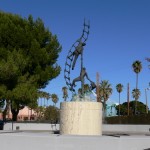Archive for the 'Wartime Merchant Marine Action' Category
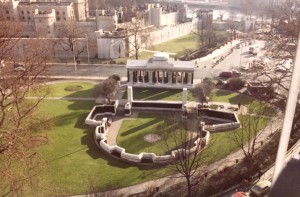
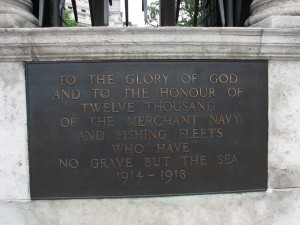 Perhaps more than any other nation, Great Britain has relied on mastery of the oceans for her greatness. From the days of empire in the 18th and 19th centuries, to the days of fighting for survival during the brutal conflicts of the 20th century, the sailors of the British Isles left the ports of England determined to serve their country. Hundreds of thousands of these souls would never return to their homeland.
Perhaps more than any other nation, Great Britain has relied on mastery of the oceans for her greatness. From the days of empire in the 18th and 19th centuries, to the days of fighting for survival during the brutal conflicts of the 20th century, the sailors of the British Isles left the ports of England determined to serve their country. Hundreds of thousands of these souls would never return to their homeland.
The Tower Hill Memorial is located across the street from two of London’s iconic sites – the Tower of London and the Tower Bridge. Separated into two parts, the memorial commemorates the men and women of the Merchant Navy and Fishing Fleets who gave their lives during WWI and WWII protecting their nation and who have no grave but the sea.
The WWI Memorial is a vaulted corridor listing the names of thousands of ships arranged alphabetically. The names of the lost are listed below the name of each vessel. The ship’s master is listed first, with the remainig dead of each ship listed alphabetically below the Master. No rate or ranking other than the Master is indicated. 11,919 names are listed in this corridor.
The WWII Memorial is in the form of a sunken garden, the walls containing the names of nearly 24,000 souls lost at sea. Teak benches allow visitors to sit and contemplate their surroundings. In the center of the garden is a ‘pool’ of bronze, engraved as a mariner’s compass set to magnetic north.
Perhaps the most powerful aspect of this memorial is when one considers the scope of the sacrifice it represents. During WWI and WWII the British lost over 8,000 merchant ships alone. This staggering figure does not include fishing or military vessels. 49,000 British merchant seamen lost their lives in the two world wars – over 50% of those lost at sea. Each name on these walls represent a story, a life too short, a loved one missed. When I visited the memorial I greatly appreciated the decision to list the names without rate or rank. These sailors who rest in sea-locked graves are all equal in the hearts of a grateful nation…
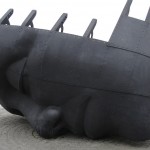
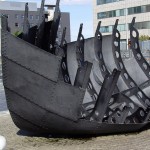
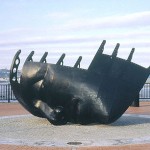 Some lost at sea memorials are touched by genius. The images they convey are timeless and universal – like all great art. The designer and sculptor of this unforgettable memorial in Wales is Brian Fell.
Some lost at sea memorials are touched by genius. The images they convey are timeless and universal – like all great art. The designer and sculptor of this unforgettable memorial in Wales is Brian Fell.
Approach the sculpture from one side or from the rear and you see a hull section of a merchant ship resting on a beach or the ocean floor, torn from the rest of the vessel, the ship’s framing exposed to the sea or the elements. Walk around to the other side and you see the face of every human lost forever to the sea incorporated in that same hull section. Expand the photos above to better appreciate this amazing piece of art.
Amethyst Marine Services Limited is the sole guardian of the memorial – a task in which they take great pride. Mr. Peter Haines of Amethyst Marine has been most generous of his time in providing me with some of the history of the sculpture and the mosaic of Italian marble on which it rests.
The memorial was commissioned in 1994 by the Cardiff Bay Arts Trust (CBAT), a charitable organization that was first established in 1991, as part of a public art effort in the Bay. Mr. Wiard Sterk of CBAT was instrumental in establishing a commission for an art piece honoring those who died in merchant service from the Cardiff Bay area. A design contest was held and the commission was awarded to Brian Fell, whose father was a merchant seaman, and who told Brian stories about ship construction methods during World War II. Once awarded the commission, Brian found the last hydraulic riveting workshop in Britain and taught himself the skills necessary to seam steel sections together to form the ship’s hull with its two very distinctive aspects. Brian’s wife served as the model for the face. The hull rests on a circular mosaic by artists Louise Shenstone and Adrian Butler. Inscribed around the edge of the mosaic are the words:
“IN MEMORY OF THE MERCHANT SEAFARERS FROM THE PORTS OF BARRY PENARTH CARDIFF WHO DIED IN TIMES OF WAR”
Peter Haines advised me that the memorial would not have happened without the efforts of the late Mr. Bill Henke MBE (Member of the Order of the British Empire). Mr. Henke was the founder of the Merchant Navy Association (Wales). He spent years raising funds for the construction of the memorial. A plaque recognizing his efforts is located just outside the circular mosaic base of the memorial – and the sculpture itself is located just outside the Welsh Senedd (parliament) building, which was built after the sculpture was erected.
The memorial is the subject of hundreds of fine photographs on Internet photo streams. Avail yourself of a look on Flickr, Flickriver, Paroramio and others. The memorial takes on different personalities under different lighting conditions, filters, and exposure levels.
I’ve spent several months researching the memorial for this short post. Two thoughts seem to run through my mind constantly about the memorial. The first is the elegant creativity of Brian Fell’s design. Few memorials possess the emotional impact of this brilliantly formed piece of riveted galvanized steel.
The second thought derives from a single line in an email from Peter Haines. When discussing Bill Henke’s essential contributions to the memorial, Peter added one final fact, which I’ll quote: “Mr. Henke actually died right next to the statue he had spent years fighting to build.”
I believe that Mr. Henke was in his early 80s at the time of his death – most of his last six decades spent serving as an active merchant seafarer, or in preserving the memories of those he knew and those he never met, but who also served at sea. I suspect late in life he took great comfort in gazing at the steel frames and riveted plates that magically form the peaceful image of friends long gone, but not forgotten. I also suspect he died at the exact place he would have wanted to be when his fellow shipmates called him to his final voyage…
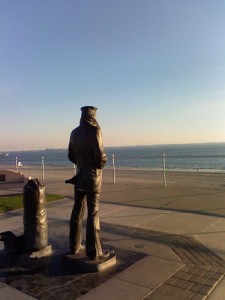 One of the most iconic sculptures found in the United States is The Lone Sailor, a tribute to those of all the sea services. The sculpture was originally created by Stanley Bleifeld for the United States Navy Memorial in Washington, D.C. It was first erected there in 1987. There are at least eleven other other copies located around the United States.
One of the most iconic sculptures found in the United States is The Lone Sailor, a tribute to those of all the sea services. The sculpture was originally created by Stanley Bleifeld for the United States Navy Memorial in Washington, D.C. It was first erected there in 1987. There are at least eleven other other copies located around the United States.
While not a lost at sea memorial per se, it most certainly represents a scene witnessed tens of thousands of times around the world – a mariner silently waiting for his ship. In all too many cases this scene would be the mariner’s last time spent on solid ground, as he would eventually become another soul lost at sea.
The design of statue always reminds me of the opening scene in the movie “The Sand Pebbles”, as Jake Holman mutters “Hello ship” to his new vessel the San Pablo.
The beautiful photograph in this post was taken by Manuel Ortiz (Mortis24 on Panoramio). It is of the sculpture found in Long Beach, California. I love the perspective in Manuel’s photograph – the sailor looking out to sea, where an unknown fate awaits…
“Jacob’s Ladder” is often used as a biblical allusion from Genesis to Jacob’s dream of a ladder reaching to heaven. For those who have served at sea it is also a term for a rope or cable ladder, with wooden steps, that hangs off the side of a ship. Jacob’s Ladders sway, twist and slap the sides of a ship with the wind and the waves. They are not a favorite piece of equipment for any sailor, but for a sailor in peril a Jacob’s Ladder can often be the only route to survival.
The main focus of the American Merchant Marine Veterans’ Memorial in San Pedro, California is the unforgettable work of art by the late sculptor Jasper D’Ambrosi of one shipmate attempting to save another while clinging by a single hand to a Jacob’s Ladder. The concept and the design of the memorial are superb – capturing courage, strength, fear and hope in a single image. It is a moment that is universal, experienced by sailors of every nation for as long as humans have sailed the oceans. It may have happened because of a battle or a storm or an accident. It is that single moment that is the dividing point between success and failure, between life and death. It is a moment that I have personally witnessed. The D’Ambrosi work is among my favorite lost at sea memorials.
The beautiful photographs in this post were taken by Alfonso Pauwells (saxxon57 on Panoramio). I encourage everyone to seek out and view his fine photographs.
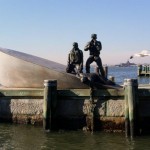 One of the most memorable lost at sea memorials anywhere is located on the west side of Battery Park in Manhattan, near the line to board the ferries to the Statute of Liberty and Ellis Island. The memorial was designed and fabricated by the artist Marisol Escobar, based on a photograph from an actual event during WWII. In that event a German submarine attacked and sank an American merchant vessel, thought to be an oiler. The submarine surfaced and took photographs of the survivors. The memorial depicts the scene in one of those photographs. The submarine did not pick up the survivors. They were all lost at sea in the vast Atlantic.
One of the most memorable lost at sea memorials anywhere is located on the west side of Battery Park in Manhattan, near the line to board the ferries to the Statute of Liberty and Ellis Island. The memorial was designed and fabricated by the artist Marisol Escobar, based on a photograph from an actual event during WWII. In that event a German submarine attacked and sank an American merchant vessel, thought to be an oiler. The submarine surfaced and took photographs of the survivors. The memorial depicts the scene in one of those photographs. The submarine did not pick up the survivors. They were all lost at sea in the vast Atlantic.
The brilliance of Marisol’s design can best be appreciated by viewing the monument over an extended period of time. At periods of high tide one can only see a hand sticking out of the water. When the tide is lower one can see the hand and the stricken seaman’s head, and at other times his entire upper torso. As ships pass by, the waves created give the memorial a sense of life and motion. The seaman’s head bobs above and below the water’s surface, as the arm of a seaman in a lifeboat strains to save his shipmate. Two others on the lifeboat are looking directly at the submarine, which will eventually submerge again and leave them for dead. There is a plaque at the memorial that reads:
Dedicated to all Merchant Mariners who have served America from the Revolutionary War through the present day. In the prosecution of war and in pursuit of peaceful commerce, unrecognized thousands have lost their lives at sea. Their sacrifices have helped secure America’s liberty and prosperity.The sculpture was inspired by a photography of the victims of a submarine attack on an American merchant ship during World War II. Left to the perils of the sea, the survivors later perished.
This memorial serves as a marker for America’s Merchant Mariners resting in the unmarked ocean depths.

